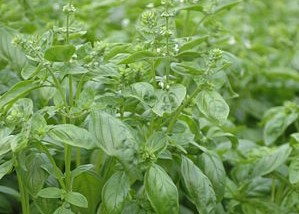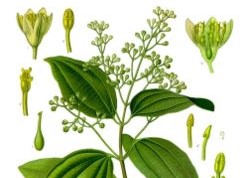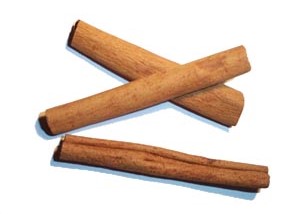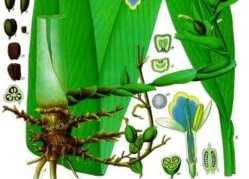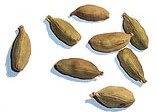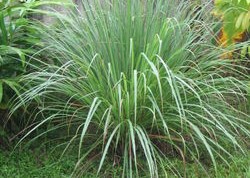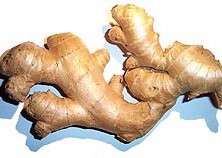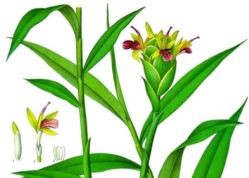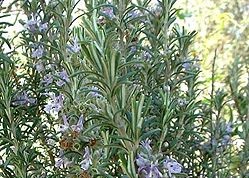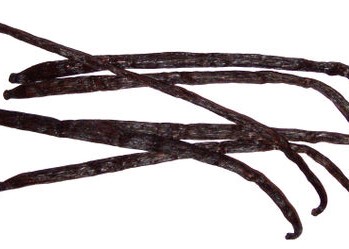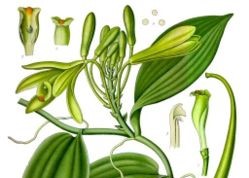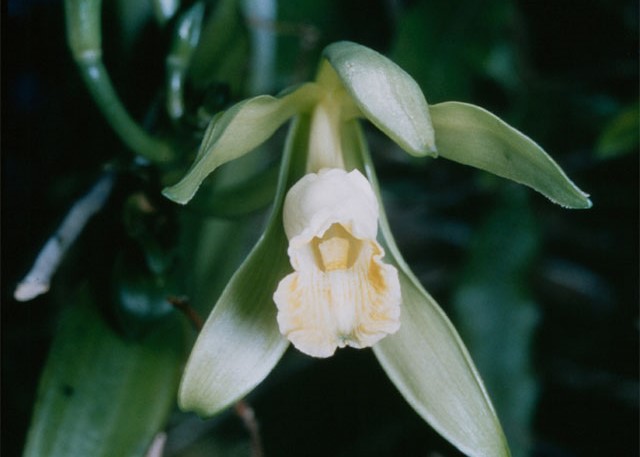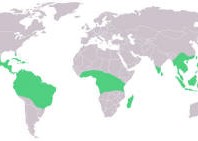Spices
1. Basil
Basil (also known as "pistou") is an annual plant of the family of Lamiaceae (Labiatae) cultivated as an aromatic plant and culinary herb. It is used for making pesto, the emblematic condiment of Italian cuisine.
· Scientific name: Ocimum basilicum L., Lamiaceae family
· Common names: common basil, roman basil, royal herb, pistou.
Description
Common basil is an annual plant measuring 20 to 60 centimetres in height, with oval leaves of 2 to 3 centimetres. The leaves are pale to dark green, sometimes purple in certain varieties.
The stalks are upright and ramified with a square section, like many of the Lamiaceae, and they have a tendency to becoming ligneous and bushy.
The flowers are small and white; the upper lip is divided into four lobes. They are small and grouped together in long tubular tufts, in the form of elongated clusters.
The seeds are slender, oblong and black.
Ocimum basilicum
The term basil would appear to derive from the ancient Greek basilikón (meaning royal plant), itself derived from the word basileús, king, from the low Latin basilicum, meaning royal, referring to the high esteem in which this herb is held.
The plant, which probably originates from Iran or India, arrived in Europe via the Middle-East: it spread to Italy and the south of France during the XVth century, to England during the XVIIth century and then travelled to American with the first emigrants.
L'Ocimum tenuiflorum, the species of sacred basil, is cultivated near the Buddhist temples, notably in Thailand.
In India, basil is a sacred plant that is offered as a gift to Vishnou, protector of the universe and to the God Krishna, saviour of the world.
In Gaul, the inhabitants gathered basil in July and August when it was in flower. The pickers of this sacred plant had to observe strict rituals of purification: they had to wash the hand that did the picking in the water of three different springs, put on clean clothes, avoid the impure (such as women who were menstruating) and not use metal tools to cut the stalks. Basil was considered a sacred plant because it supposedly had the power to cure cuts and blows, especially those caused by arquebuses. It was therefore used with red water to make special lotions for healing wounds.
Uses
In the kitchen
As a fresh aromatic herb in salads, or with ripe tomatoes, courgettes, garlic, shellfish, fish (mullet), scrambled eggs, chicken, rabbit, duck, mixed salad crudités, rice, pasta and sauces (vinaigrettes, lemon, olive oil). It is better used fresh as it is not suitable for cooking any length of time as it loses all its flavour. When using basil for hot dishes, it should be added just before the dish is served in order to conserve its fresh, intense flavours. Also, for this same reason of preserving its flavour, it should not be blended. However, it can be pounded with a mortar and pestle.
· Pesto (Ligurie), this is the star recipe using basil and comes from the north-west of Italy. Pounded with olive oil, pecorino (or parmesan can be used), pine nuts and garlic, it makes a creamy sauce which accompanies pasta.
· Pistou (south of France): this recipe resembles that of Italian pesto, but is prepared without the pine nuts and accompanies summer vegetable soups and haricot beans, pasta, courgette and aubergine fritters.
In the medicine cabinet
· Part of plant used: leaves and flower heads
· Properties: Stomachic, carminative, lactagogue
· Used in the form of: infusion, powder, essential oil, medicated wine, poultice
Sedative, antispasmodic for the digestive tract, diuretic, antimicrobial, relieves indigestion and vermifuge. It is also reputed to keep away mosquitoes and is a remedy against nyctalopia.
2. Cinnamon (bark)
Cinnamon is the bark of the Cinnamomum verum (cinnamon tree, synonym. Cinnamomum zeylanicum), an evergreen tree belonging to the Lauraceae family native to Sri Lanka.
Description
The cinnamon tree is 10 to 15 metres tall. Its bright green, oblong shaped leaves are 7 to 18 cm long. Its flowers are greenish and have a distinct somewhat unpleasant odour. The fruit of the cinnamon tree is a purple berry that is one-centimetre in diameter. The bark is harvested in the rainy season. That is cut into cinnamon quills.
Uses
Cinnamon has been known since antiquity and was used by ancient Egyptians in the embalming process.
The tree is grown almost everywhere in the world but the best quality is produced in Sri Lanka. The latter has a magnificent light-yellowish brown colour, a highly fragrant aroma and a very sweet, warm and pleasant taste. Its flavour comes from the oil that it contains.
Cinnamon has been used in numerous preparations from the Middle Ages to the current time.
This spice can be found in, among others, the famous "hypocras", a medieval drinks.
Cinnamon is mainly used in cookery as condiment and to add flavour, for example, combined with apples, for preparing chocolates and liqueurs, as well as in Indian food.
| Production in tons | Figures for 2003-2004 | % |
|---|---|---|
| China | 47 000 | 44% |
| Indonesia | 39 000 | 37% |
| Sri Lanka | 12 200 | 11% |
| Vietnam | 6 000 | 6% |
| Madagascar | 1 500 | 1% |
| Seychelles | 230 | 0% |
| Eastern Timor | 75 | 0% |
| Dominica | 55 | 0% |
| Grenada | 50 | 0% |
| Sao Tome e Principe | 30 | 0% |
| Total | 106 140 | 100% |
3. Cardamom
The dried fruit it used. It looks like a green grey capsule, with three compartments containing dark brown seeds which are the only aromatic part of the plant. However, the fruit, which turns yellow whilst it is drying, is sold whole in order to avoid any deterioration of the seeds.
The seeds are used in Indian cookery and more generally in Asian cookery as well as in Africa, in particular Ethiopia, whole or in a powder. Cardamom has a very strong smell and should therefore be used with precaution. On the other hand it is not spicy hot.
Cardamom can also be used for the production of mead.
There is also another plant, called black cardamom, whose pods are much fatter, darker and slightly hairy.
Historically, cardamom was first used during the Middle Ages.
It was part of the mixture of spices that were used to transform red wine (difficult to conserve in the Middle Ages) into hippocras, which was served as an aperitif. It is not very often used in Europe, except in gingerbread and in cookery in the Scandinavian countries. It is also often used to flavour coffee and Chai tea.
4. Lemon grass
Scientific name: Cymbopogon citratus (DC.) of the Poaceae family, sub-family of Panicoideae, tribe of Andropogoneae.
Common name: lemon grass, lemon herb, Indian verbena, sweet rush.
In France in the perfume industry, it is also known under the name of schenante.
Description
Herbaceous plant with long vertical leaves growing 90 centimetres to 2 metres in height, with rough, sharp edges and pale green in colour. It is a perennial rhizome grass.
Distribution
The plant originates in the south of India. It can also be found in various regions of Africa.
Use
The base of the fresh stalks are cut into slices and used to flavour raw vegetables, salads, marinades and soups. It is a traditional ingredient of south-east Asian cookery (India, Vietnam and Indonesia). Cooks in Thailand and Vietnam use the lemon grass stalks to give a lemon flavour to their dishes. The only part of the "sweet rush" which is eaten is the tender base of the stalk, around 6 to 7 centimetres in length.
Essential oil is also made from lemon grass and used as a mosquito repellent.
5. Ginger
The etymology of ginger defines it as deriving from a word in the Indian language prâkrit; "singabera" which means "in the form of a horn". It has come into our language via the Greek word zingiberis and then the Latin word zingiber.
Botanical characteristics
Ginger is a tropical perennial herbaceous plant growing around 1.50 m in height from a rhizome. The leaves are evergreen, long and have a powerful smell. Once it has flowered, a short spike enclosing the black seeds in capsules appears at the end of the stalk covered with scales. The flowers are yellow-white speckled with red. Ginger likes to be exposed to the sun and thrives in a humid environment. It grows rapidly and multiplication is obtained by division of the roots.
History
It was called zenj by the Arab merchants. This word was also used by them to describe the inhabitants of the east coast of Africa and where the word "Zanzibar" derives, for it is here that the Arabs went for their supplies of ginger.
Production
| Production in tons | Figures for 2003-2004 | % |
|---|---|---|
| India | 275 000 | 27% |
| China | 259 719 | 25% |
| Indonesia | 151 000 | 15% |
| Nigeria | 110 000 | 11% |
| Nepal | 90 000 | 9% |
| Bangladesh | 43 000 | 4% |
| Thailand | 33 000 | 3% |
| Philippines | 30 000 | 3% |
| Other countries | 39 259 | 4% |
| Total | 1 030 978 | 100% |
Uses of Ginger
Cookery
· The young roots of ginger are juicy and fleshy and have a sweet flavour. In Japanese cookery they are used marinated in vinegar and in India they are used as an ingredient for making masala.
· The mature roots are fibrous, almost dry and are more strongly flavoured. As they get older, so the flavour intensifies and they are often used in Chinese cookery to cover strong smells and flavours such as those of seafood and mutton. This spicy and smelly flavouring is caused by the compound zingerone.
· Marinated ginger (gari) is used to refresh the palate between mouthfuls when sampling sushi.
· Ginger is also used for flavour when making cakes and pastries and is the principal flavour in ginger ale, a Canadian fizzy drink, which is sweet and non-alcoholic and ginger beer, an English beer made with ginger.
· Dried ginger, in powder form, is used to flavour ginger bread and other recipes. It has a totally different flavour from fresh ginger and it is impossible to substitute one for the other.
· Ginger is also used to flavour tea in the Swahili cultivation zones.
Health Care
· In the year 2000, a number of medical researches grouped together, officially acknowledged that ginger efficiently reduces nausea after operations. It is also known for relieving kinetosis or travel sickness. Ginger can be consumed fresh or in the form of powder in capsules.
· Traditionally, Chinese women ate the root of ginger during pregnancy to relieve morning sickness.
· Ginger lowers the level of cholesterol, blood triglyceride,
· The root of ginger is also reputed to be an aphrodisiac.
6. Rosemary
Description
Rosemary can grow up to 1.50 metres in height. It is easily recognised in all seasons by its evergreen leaves that have no petiole. The leaves are tough, much longer than they are wide, with slightly curved in edges; they are shiny dark green on the topside and whitish underneath. The smell, which is strongly camphorated, evokes that of incense. Rosemary comes into flower as early as the month of February (sometimes even January) and continues until April-May. The colour of the flowers, which are formed in clusters similar to tufts, varies from pale blue to mauve (the variety which has white flowers, R. officinalis albiflorus is more rare). As with the majority of lamiacea, the fruit contains a single seed, which is brown in colour.
Cultivation
Rosemary grows where the climate is hot and dry. It can be reproduced by taking cuttings or layering in the spring or autumn. It can also be sown.
Different uses of Rosemary
Cookery
Rosemary is very easy to dry and highly appreciated as a herb for all sorts of preparations. It can be used in stews and ragouts, in soups, marinades and with grilled meat. It is also used to flavour puddings and jams.
Phytotherapy
Rosemary is reputed to activate and facilitate the digestive system, in particular the function of the gall bladder. It is also anti-spasmodic and its power to stimulate the nervous system means that it can be recommended in the treatment of various types of asthenia.
The properties of rosemary are contained in the leaves and the tips of the flowers. One of the easiest ways to use it is to make an infusion (or decoction), where its digestive properties work wonders. It can also be taken in the form of capsules, which you can buy at the chemist, if the treatment lasts a long time. It is also available in the form of essential oil and can be used either as a massage oil, bath oil, or it can be taken orally.
Perfumery
The use of rosemary as a perfume goes back a long way. Particularly well known is Queen of Hungary Water, an alcoholate frequently used in the XIVth century, of which rosemary is one of the principal components. The name comes from Queen Elisabeth of Hungary who is said to have used it in 1378 at the age of 78 years old; the water gave her back her youth to such an extent that the king of Poland asked her to marry him!
Legends
According to the legend, the rosemary plant originally had white flowers. Before giving birth to the infant Jesus, Mary is said to have left her blue cloak on a rosemary bush planted in front of the stable. The colour run off the cloak onto the bush and that is why, ever since, all rosemary bushes have blue flowers.
Some people see in this legend another possible origin of the name Rosemary, that is " Rose de Mary " or Mary's rose. Indeed this is the origin of the English name Rosemary.
7. Vanilla
The plants which produce vanilla also bear the name vanilla, or sometimes vanilla plant. They are the only orchids which are cultivated for reasons other than ornamental.
In order to obtain a spice which is rich in flavour, the cultivation and preparation of vanilla requires much care and attention. So in proportion to its weight, this makes vanilla one of the most expensive agricultural products in the world. It comes in the form of long, thin, shiny black fingers which are commonly known as "vanilla pods".
Appellations
Etymologically, the name vanilla derives from the Spanish word vanilla, which issues from the Latin word vagina and signifies sheath, pod or case.
Botanical Description
The vanilla liana, also known as vanilla plant, is supple, with few ramifications and forms long shoots with which it can climb up a support of more than 10 metres high. If the stem is snapped in pieces, the parts which have been broken will readily put out new shoots, thus enabling the multiplication of the plant in the wild as well as when cultivated.
The leaves are disposed alternately on each side of the stem. They can measure up to fifteen centimetres. The stem and the leaves are green, fleshy, filled with a transparent and irritating sap which burns the skin and causes a persistent itch.
The flowers are arranged in groups of eight or ten and form small bouquets.
White, greenish or pale yellow in colour, they possess the classic structure of the orchid flower despite a fairly regular appearance.
Pollination requires the intervention of an outside agent: in the wild, in the region where vanilla originates, pollination is carried out by insects of the genus Melipona, a type of bee. After fertilization, the ovary is transformed into a hanging pod, measuring between 12 and 25 centimetres. The fresh pods have no scent and a diameter of between 7 to 10 millimetres. They contain thousands of tiny seeds which are normally liberated when the ripe fruits burst, unless they are harvested whilst still green.
Vanilla originates from the east cost of Mexico, where it can be found in the undergrowth of the humid tropical forests.
But vanilla is known above all as a cultivated spice, and, thanks to its history, vanilla is now grown in most of the wet, tropical climates of the world.
The history of a spice that has conquered the world
The tlilxochitl of the Aztecs
At the time of the Aztecs, vanilla was already known and valued by them. They called it Tlilxochitl. They used it mostly to flavour a drink made with cocoa.
Vanilla appeared in the court of Spain at the beginning of the XVIth century, but international trade only really took off in the following century.
The Mexican Monopoly
For more than two centuries, from the XVIIth to the XVIIIth centuries, Mexico, and in particular the region of Veracruz, conserved a monopoly on vanilla.
All efforts made to grow this orchid outside of its natural habitat failed. The problem was that until the XIXth century nobody realised that the honey bees played a critical role in the pollination of the flowers, which was essential for the formation of the fruit.
A real craze for vanilla was by now beginning in Europe. It was notably highly appreciated at the court of France, where Madame de Montespan used it to perfume her bath. Under the charm, Louis XIV decided to seriously try and introduce the vanilla liana to the Island of Bourbon. However, the various attempts made during his reign all failed.
The influence of the Island of Bourbon
The first artificial pollination of the vanilla plant was carried out in 1836 in the botanical gardens of Liège by the Belgian naturalist, Charles Morren, then in 1837 by the French horticulturist, Joseph Henri François Neumann.
However, it was not until 1841 that a young slave of twelve years old from the Island of Bourbon, Edmond, developed the practical procedure which is still used today. This method of pollination, of which Jean-Michel-Claude Richard tried to appropriate the discovery, made the Island of Bourbon (today known as Reunion Island) the leading vanilla plant centre of the world only a few decades after the introduction of the orchid there in 1819. When slavery was abolished in 1848, the young Edmond was given the patronymic Albius, in reference to the colour "white" (Alba) of the vanilla flower.
The Rise of Vanilla in Madagascar
It was the planters of Reunion Island who introduced the cultivation of vanilla to Madagascar around 1880. The first plantations were established on the Island of Nosy Be. From there they took hold in the eastern part of the great island, in the regions of Antalaha and Sambava where the humid climate is favourable to the cultivation of vanilla. Enthusiasm for the spice was immediate and Madagascan production was more than 1,000 tonnes in 1929, which is more than ten times that of Reunion Island. But the market was not well regulated and as a result vanilla periodically went through crisis of overproduction.
In spite of competition from other tropical countries such as Indonesia, and the emergence of new dynamics in the conquering of markets such as in the State of Kerala in India, Madagascar still conserves even today its status as the number one exporter of vanilla in the world.
Different types of cultivation and the care of vanilla
Plantations
In order to grow, vanilla needs a hot and humid climate, a support on which to cling and a certain amount of shade. On the whole, three different plantation techniques are used, from the most extensive to the most intensive:
· in undergrowth, using tree trunks as support
· in intercrop cultivation, for example between rows of sugar cane
· in a shaded environment.
The farmers carry out propagation, make sure the plants can cling onto their support and pay particular attention to placing the liana so that the future vanilla pods can grow at the height of the average man.
Fertilisation
Fertilisation must be done manually, one flower at a time. The process is exactly the same today as it was when developed by Edmond Albius. It is carried out early each morning (because the life span of the flowers is only a few hours at the beginning of the day) and when the weather is dry (because rain is a disadvantage in the formation of the fruit).
Preparation
The transformation of the fruit which are entirely without scent into a tender and pleasantly perfumed spice requires meticulous and methodical preparation, the principles of which were developed in Mexico a long time ago. The most simple method, known as direct preparation, consists of leaving the pod to mature by exposing it alternately to shade and sun, but the results are mediocre. That is why the method of indirect preparation is more commonly used. It starts with a brutal shock that "kills" the pod, followed by a series of operations that transform, dry and sort it and which last around ten months before the end product is finally available: the vanilla pod is ready for market.
The pod can be "killed" in a variety of ways: it can be put in the oven, subjected to cold, to infrared rays, soaked in alcohol and so on. But the method most commonly used today is to soak it in hot water. That is how the process developed in 1851 by Ernest Loupy, a native of Reunion Island, first started. It was developed from a procedure carried out by the Mexicans and subsequently made largely known by David de Floris. Here is a description of the different stages:
· soaking in hot water: wicker baskets are filled with up to 30 kg of green vanilla pods which are then plunged for three minutes in hot water at a temperature of 63°C.
· steaming: the pods are then immediately placed between wool blankets in large crates for twelve to fourteen hours; kept warm like this they dry out, are subjected to enzymatic transformation and thus acquire their lovely black chocolate colour;
· drying: from two to six weeks, depending on its potential degree of quality, the vanilla is dried several hours a day on oven racks, then in the sun and finally in the shade in order to obtain the highest quality.
· storage in crates: the vanilla is then left to mature for eight months in secret in wooden crates which are lined with greaseproof paper; it is during this period that the fragrance develops. The crates are regularly inspected in order to take out any pods that have gone mouldy so that they do not contaminate the others.
· grading: the pods are sorted according to their length; the longest are the most sought after.
· packing: traditionally, pods of the same length are bundled together, otherwise they are packed in bags.
Aromatic Profile
Natural vanilla develops a complex perfume formed of several hundreds of different aromatic compounds. Amongst these it is however the vanilla molecule (4-hydroxy-3-methoxybenzaldéhyde) that is dominant in the formation and characterisation of the aroma of vanilla.
Commercial Products
The commercial term vanilla applies to the end-product pods that are at least 15 centimetres in length. If a pod is of good quality it can be coiled around the finger without sustaining any damage.
The very best quality vanilla is found in frosted vanilla where the vanillin has crystallised on the surface in fine, snowy efflorescences. It is the most intensely and delicately perfumed vanilla you can find.
Poorer quality pods are used by the wholesale trade for the industrial food industry, or they are used in the preparation of extract of vanilla or vanilla powder. Extract of vanilla is obtained by macerating the pods in alcohol, whereas powder is obtained by grinding.
Vanilla-producing Regions
The cultivation of vanilla has spread to various humid, tropical regions of the world. However, two countries, Madagascar and Indonesia, assume the main world production. Whilst during the 1990s Indonesia was the leading producer of vanilla, Madagascar has now regained its dominant position.
In Madagascar in 2004, vanilla provided a livelihood for 80,000 planters. It is mainly cultivated in the region of Sava in the north-eastern part of the island where 24,000 of the 29,500 hectares are planted. The other plantations can be found around Diego Suarez where there are 1,500 hectares and 3,800 hectares in the region of Toamasina, from whose port the spice is exported. Other countries that have a long tradition of cultivating vanilla continue to supply the world market, although on a more modest scale, such as Mexico and the Comoro Islands. Reunion Island and Tahiti produce fewer quantities but supply a high quality product at the top end of the market. The Seychelles and Mauritius Island no longer produce vanilla.
Production in the south west of the Indian Ocean also qualifies for the Bourbon vanilla label of origin, whether it comes from Madagascar, the Comoros Islands or Reunion Island.
In Reunion Island, production is concentrated along the coast au vent between Sainte-Suzanne and Bras-Panon. In the archipelago of Comoros it is located in Anjouan and Mayotte. Vanilla is one of the only resources of the Union of Comoros along with cloves, another type of spice from which vanillin can be produced.
New countries have also launched or re-launched their own production of vanilla, such as Uganda, the State of Kerala in India, Papua New Guinea, the Tonga Islands and so on. Whilst searching to diversify their agricultural revenue and make good profits in order to end up with a high quality spice, they are nonetheless confronted with the uncertainties of an extremely fluctuating market in addition to manufacturing a product that requires precise and rigorous attention to its needs during the lengthy process of preparation.
China also produces vanilla in the province of Yunnan.
Production Figures
| Annual Production (in tonnes) of vanilla - source : FAOSTAT | |||||
|---|---|---|---|---|---|
| 1964 | 1974 | 1984 | 1994 | 2004 | |
| China | 0 | 0 | 0 | 400 | 900 |
| Comoros | 175 | 160 | 160 | 131 | 140 |
| Indonesia | 150 | 300 | 520 | 1770 | 2387 |
| Madagascar | 1050 | 2283 | 2277 | 1320 | 6000 |
| Mexico | 90 | 29 | 161 | 167 | 189 |
| Uganda | 10 | 10 | 10 | 20 | 70 |
| French Polynesia | 100 | 21 | 6 | 13 | 43 |
| Reunion Island | 45 | 27 | 56 | 33 | 35 |
| Tonga | 0 | 10 | 16 | 100 | 130 |
Competition from industrial artificial flavours
In 1874, Dr Willhelm Haarmann, a German chemist, made the synthesis of the first artificial vanilla from coniferin, an extract of spruce resin. Other substances with an aromatic nucleus can also serve as a basis for synthetic vanilla. It was by using eugenol, extract of cloves that the production and business of artificial vanillin began.
Artificial vanillin is gradually becoming more and more important in the food trade as well as in the industry of perfumed products. Thanks to its low production cost, vanilla flavouring has become more and more popular the world over, whilst at the same time imposing severe competition on natural vanilla. World production of industrial vanillin is currently estimated at around 12,000 to 15,000 tonnes a year, whereas all the natural vanillin that could be extracted from world commercial production represents less than 50 tonnes per year.
Other industrial processes for the manufacture of vanillin have also enabled producers to benefit from the use of raw materials that are less and less expensive: petrochemical synthesis, synthetic production of lignin from the residues of the paper-making industry, oxidation of curcumin extracted from turmeric or bio-technological preparation through controlled fermentation of the residues of the pulp of sugar beet used by the sugar industry.
Because the molecule is chemically the same as that present in nature, industrially produced vanillin is qualified as naturally identical flavour. In application of European regulations, vanillin can be indicated as a food ingredient with the simple mention of flavouring, whilst under American law it has to be mentioned as artificial flavouring. On the other hand, in all cases, the term natural flavouring is reserved for the use of vanilla or vanilla extract.
Medicinal properties
Known as a stimulant for the nervous system, vanilla is used in the form of essential oils, tincture, or infusion against hysteria, depression and bouts of melancholy. It is also recommended for stimulating muscular efforts and for relieving rheumatism.
